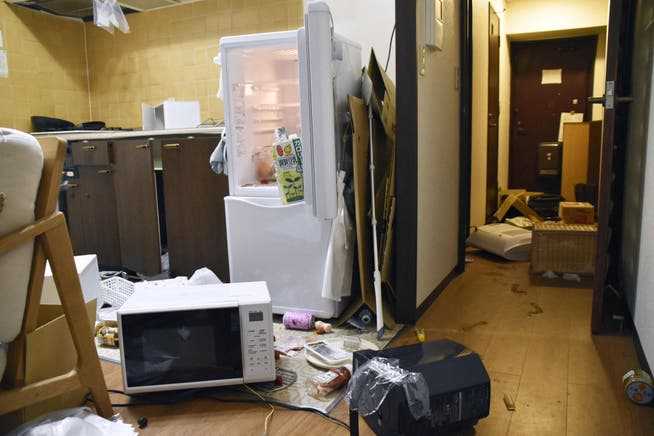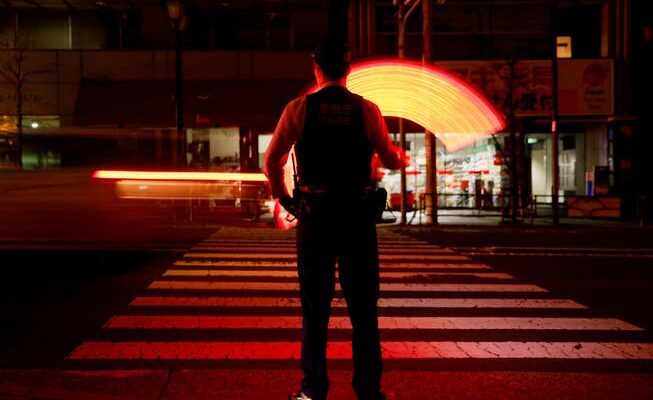Almost eleven years after the tsunami and the nuclear accident in Fukushima, northern Japan is again hit by a violent seaquake. Authorities have issued a tsunami warning. The power went out in millions of households, including in the capital Tokyo.
A police officer directs traffic in Tokyo after traffic lights failed. The earthquake on March 16 left many districts without electricity for hours, affecting a total of over two million households in the region.
A strong earthquake shook Fukushima and large parts of eastern Japan late Wednesday evening (local time), including the megacities of Tokyo, Yokohama and Sendai. There, high-rise buildings swayed for minutes, elevators got stuck. Japan’s weather agency issued a warning of a tsunami up to one meter high for Fukushima and Miyagi prefectures.
Power outages occurred not only in Fukushima, but also in large parts of eastern and northern Japan – from Shizuoka to the greater Tokyo area to Aomori. At least two million homes in nine prefectures were affected, according to electricity providers.
In Tokyo alone, 700,000 households lost power. Entire districts in Tokyo, almost 300 kilometers from the epicenter, were dark. It was not until around three o’clock (local time) that the power supply in the capital was largely restored, but not so in Fukushima and Miyagi.
The Tokyo government set up an emergency staff in the basement of Prime Minister Fumio Kishida’s official residence. The head of government chairs the Urgent Emergency Response Center, which is convened by default for earthquakes of magnitude 6.0 or greater in Japan.
Fire alarm in nuclear power plant
In the Fukushima Daiichi nuclear power plant, which was damaged eleven years ago, there was a fire alarm in a turbine building, as the operator Tokyo Electric Power (Tepco) announced. Pumps also failed in a cooling pond for used fuel rods from the second nuclear power plant, Fukushima Daini, twelve kilometers south of the nuclear ruins.
There is also said to be damage to the building. According to media reports, the measuring stations in the area have so far shown normal values. There were initially no reports of irregularities from the nuclear power plant in Onagawa in Miyagi.
According to a report by the Japanese television station NHK, a Shinkansen express train between the towns of Fukushima and Shiroishi-Zao derailed. Japanese Prime Minister Fumio Kishida announced at a press conference shortly before 2 a.m. (local time) that no passengers were injured. 96 people were on board.
Japanese trains are known for their high safety standards, triggering emergency braking during earthquake warnings. Many commuters who wanted to take the last trains home were stranded at train stations.
The authorities in Fukushima Prefecture are now reporting many injuries and damage to buildings. According to television reports, several fires have also broken out there.

The intensity of the quake near the epicenter in Fukushima knocked over furniture and electrical equipment in this apartment.
Aftershock warning
The long-lasting 7.3 magnitude earthquake struck at 11:36 p.m. (local time) at a depth of 60 kilometers off the Pacific coast of Japan in the east of the country.
According to NHK reports, the quake was so strong near the epicenter that it was almost impossible to stand up straight. On the Japanese earthquake scale Shindo strengths of the second highest level 6 plus 7 were recorded in Fukushima.
The Japanese weather agency warned of tsunamis of up to one meter in height in the Fukushima and Miyagi regions. So far, several tsunamis of between eight and a foot have been recorded in the ports of the cities of Ishinomaki and Sendai. The weather agency continues to urge caution, as tsunamis can roll towards the coast several times after a severe earthquake.
In a press conference at night, a representative of the authority also warned of further severe aftershocks in the next one to two weeks, which could reach a magnitude of 6 or higher. Caution is advised, especially in the next two to three days.
The earthquake brought back memories of the devastating catastrophe eleven years ago. On March 11, 2011, the region in north-eastern Japan was devastated by a devastating magnitude 9 earthquake and the resulting tsunami. The floods killed around 20,000 people.
As a result, there was a meltdown at the Fukushima Daiichi nuclear power plant in Fukushima. It became a symbol of the triple catastrophe known as “3/11” all over the world. To date, around 34,000 people have been unable to return to their homes because of radioactive radiation.
Severe aftershocks continue to occur in the region many years after the disaster. Almost a year ago to the day, on February 13, 2021, a magnitude 7.3 earthquake was also recorded off the coast of Fukushima. A tsunami warning was not issued at that time. However, there were landslides and damage to buildings, as well as power outages in several hundred thousand households.
Japan is located on the so-called Pacific Fire Belt, which stretches from New Zealand through Indonesia and Japan across the Bering Strait and along the west coast of the USA to the southern tip of South America. More than 90 percent of the earthquakes worldwide happen there.
